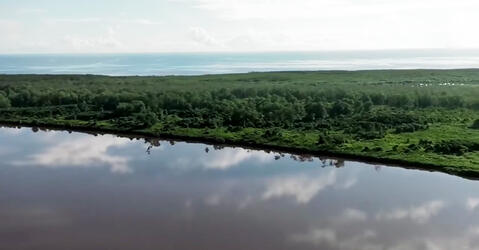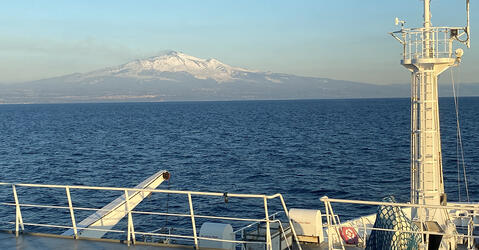You are here
The Bioacoustics of Sperm Whales
These unusual images of sperm whales were produced by scientists. Hence the black bar, that acts as a guide and the little dots that appear on the whales. They indicate the source of the strange noises or clicks produced by these animals.
They emit these sounds to orient themselves, communicate, and hunt.
A single sperm whale ingests around 400kg of prey per day. They are the biggest marine hunters, at the very top of the food chain. They’re also mysterious, living most of their lives in total darkness, at depths below 1000m.
Herve Glotin
Cetaceans are the oceans’ super predators. You have the sperm whale, blue whale, and dozens of other species. But we don’t know enough to explain their role within the food chain, how they regulate it. Or even how climate change will affect them.
This species lives in total darkness, so it can be better studied using sound. The best method for observing these animals is to listen to them and develop instruments and algorithms to record and understand the sounds they make.
We’re at the information systems laboratory at the University of Toulon. A one of a kind device has been developed here. It is built around a sound card, named Jason which makes it possible to observe marine wildlife using a set of microphones.
Valentin Barchasz
This sound card can record five audio channels simultaneously at a very high frequency, while using very little energy.
It was quite difficult to develop because we had to combine performance AND autonomy - two things that usually don’t go well together.
The idea here is to place the system in underwater tubes, in a watertight enclosure. Everything has to work for ten days to a month. And this is why the system can’t be too energy-hungry.
In the port of Toulon, Jason will be put to the test. Today, it’s being installed aboard Shyrna an autonomous ship. It is the largest of its kind in the world. It has been equipped with five hydrophones - microphones that work in water - all linked to Jason’s five-way recorder. Sphyrna will drift for days, listening to sperm whales and following their movements from the surface, all the way to the abyss.
In order to find their way in the dark, sperm whales see using sound, detecting the surrounding elements through sonar. More precisely, the clicks that they emit, and the echoes made by walls and prey, enable them to clearly perceive their environment.
Hervé Glotin
Sound propagates remarkably well in water, much farther than through air, while retaining most of its qualities. Animals, let’s say marine mammals, have used this property for millennia and have evolved to become specialists in submarine acoustics.
The scientific mission today is focusing on bioacoustics, the discipline that analyzes sounds emitted by living things.
Herve Glotin
With this analysis, we’re looking to understand individual animals: their size, age, and behaviors. We want to know if they emit sounds that reflect social behaviors, or if they’re making sounds suited to locating prey. These signals contain a lot of information about the objectives and strategies of these animals as they explore their environment, and can even give clues about their intelligence.
The Jason soundcard installed on Sphyrna is a veritable “acoustic camera.” It enables scientists to precisely locate sperm whales within a range of 5km. But in order to trace the movements of these animals in three dimensions, we must return to solid ground and the laboratory which can crunch the data.
Maxence Ferrari
The amplitude of the clicks is drowned out in the rest of the signal. And so the first challenge in isolating the clicks from the signal is to remove all of the background noise. Once we have located all the clicks, we can calculate their location spatially relative to Sphyrna.
Thanks to a triangulation method using the five hydrophones, the team can retrace the exact trajectory of the animal in order to study its behavior.
Marion Poupard
Here we have the sperm whale that spent three hours diving. It made different dives that each lasted about 40min. Its first dive went close to 1500m deep, it came back up, and then did that again three times along the canyon to optimize its hunt for prey. One of the objectives of this study was to see if there was a link between the clicks we receive and the trajectory of the animal. In other words, when it stops clicking does it move more or less quickly?
The different trajectories were reconstructed. Each point here corresponds to a click emitted by the sperm whale. This model enables the precise measurement of the movements of super predators which hunt near the coasts and, notably, to see how they adapt to human activity.
Herve Glotin
We have to understand that the noises created by humans mask environmental sounds, effectively rendering cetaceans blind. It’s like being blinded by flashes of light, because they must be able to hear in order to see their environment. The more ferries and other disturbances like them, the less these animals can thrive. And so either they’ll have to leave these waters, or there simply won’t be room for them to survive.
This new method of bioacoustic analysis opens the door to a deep behavioral study of these mysterious sperm whales. Understanding their hunting techniques or reproductive strategies might better enable a harmonious coexistence between humans and these massive marine mammals.
Tracking the Elusive Sperm Whales
Sperm whales spend most of their lives hunting in the depths of the sea. To study them, a team of researchers used a floating autonomous ship equipped with microphones and a sound card so powerful that it can locate the animals with pinpoint accuracy.





